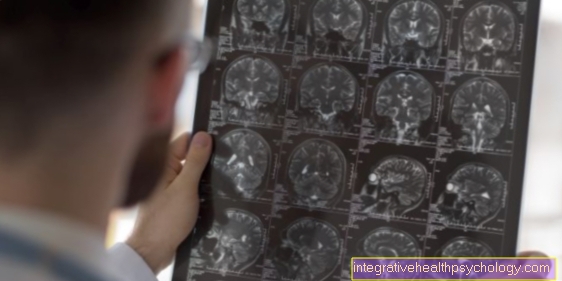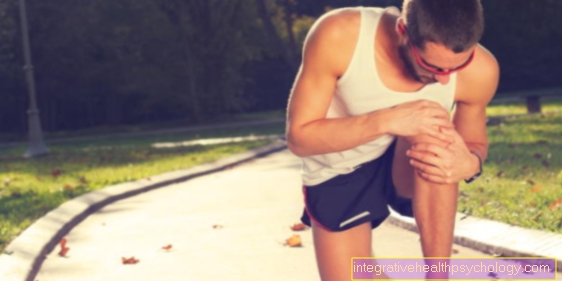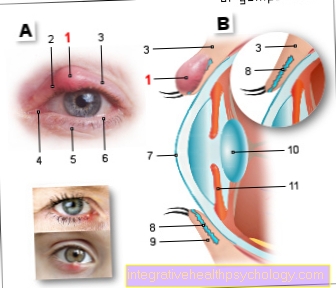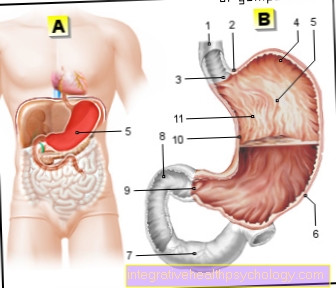Trochanteric bursitis - inflammation of the hip bursae
General
Trochanteric bursitis is one Inflammation of the bursae of the hip joint.
In the hip joint there are three larger bursa that are not just through Improper loading can ignite. In the three types of bursitis of the hip joint, parts of the three gluteal muscles that attach to the thigh bone are affected. These are the gluteus maximus muscle, the gluteus medius muscle and the gluteus minimus muscle.

The bursa serve to separate the bone and the muscle from each other and create one Sliding layer to build. They also dampen our movements. The so-called trochanter of the thigh bone is a part of the bone to which many muscles of the hip joint attach.
Trochanteric bursitis is therefore an inflammation of the bursa, which is located between the three gluteal muscles and the upper bone of the thigh.
frequency
How often one Bursitis of the hip joint cannot be said with great accuracy, as many forms of these diseases fortunately heal very well.
According to some studies, the unilateral Trochanteric bursitis is more common in both women and men than bilateral bursitis. Overall, more than half of the patients have bursitis Female.
The disease occurs on average 1-2:1000 Patient.
causes

In order to understand the causes of the development of trochanteric bursitis, the anatomy of the affected structures must first be made clear. The roll mound, a bony structure of the thigh, is an attachment point for many muscles of the hip. This creates enormous mechanical stress in this area, which in turn is largely diverted to the bursa, the trochanteric bursa. In trochanteric bursitis, the mechanical stress on the bursa has become so great that it has become infected.
A distinction is made between septic inflammation and aseptic inflammation.
Septic inflammation is a disease that is triggered by external pathogens such as bacteria. Inflammation caused by the bacterium Staphylococcus aureus is particularly common.
Aseptic bursitis is inflammation that is triggered by the above-mentioned chronic inappropriate stress. Sports that put a lot of stress on these muscles are therefore risk factors for the development of trochanteric bursitis. Long-distance runners and wrestlers are often affected by the disease, as these sports put enormous stress on the hip muscles. But also people who do not do competitive sport, but have an improper load, can be affected by trochanteric bursitis. As a result, the bursa is particularly irritated and it comes to a bursitis.
Bursitis can also be triggered by trauma, for example in the context of an accident. In the context of chronic diseases such as rheumatoid arthritis, inflammation of the bursa can also occur.
Other risk factors for developing bursitis can be pelvic obliquity due to legs of different lengths, poor gait, standing for too long, unaccustomed strain or previous injuries or hip operations. Trochanteric bursitis is also common in people with knock knees. Here the angle between the femoral head and the femoral shaft is relatively small compared to unaffected persons (<120°). In addition to the knee joint, a knee joint also affects the hip joint including the bursa, which can often become inflamed as a result of heavy stress in affected persons.
Also read more on the topic: Bursitis on the knee
Appointment with a hip expert?

I would be happy to advise you!
Who am I?
My name is dr. Nicolas Gumpert. I am a specialist in orthopedics and the founder of .
Various television programs and print media report regularly about my work. On HR television you can see me every 6 weeks live on "Hallo Hessen".
But now enough is indicated ;-)
The hip joint is one of the joints that are exposed to the greatest stress.
The treatment of the hip (e.g. hip arthrosis, hip impingement, etc.) therefore requires a lot of experience.
I treat all hip diseases with a focus on conservative methods.
The aim of any treatment is treatment without surgery.
Which therapy achieves the best results in the long term can only be determined after looking at all of the information (Examination, X-ray, ultrasound, MRI, etc.) be assessed.
You can find me in:
- Lumedis - your orthopedic surgeon
Kaiserstrasse 14
60311 Frankfurt am Main
Directly to the online appointment arrangement
Unfortunately, it is currently only possible to make an appointment with private health insurers. I hope for your understanding!
Further information about myself can be found at Dr. Nicolas Gumpert
Occurrence of right / left / bilateral bursitis
Trochanteric bursitis is equally likely to occur on both sides, and often on both sides. If the symptoms persist on one side of the body, it could be helpful to examine your own gait or still image more closely. As mentioned earlier, the bursitis of the hip region is often persistent Pressure load of the hip joint. Not infrequently are for it Bad posture, leg length differences, pelvic tilt or one Relieving posture responsible, which is assumed in the context of chronic back pain. Also Misaligned legs Operations or injuries to the lower extremity can lead to uneven loading of the hip joint.
If trochanteric bursitis causes problems on one side of the body, it can be helpful to take appropriate measures, such as the use of Walking aids to relieve. Also Gait training together with a physiotherapist can help to compensate for improper stress. If trochanteric bursitis occurs on both sides, the patient is often severely limited due to the pain.
Symptoms

In the aseptic form of bursitis of the hip joint, there is initially an increased feeling of pressure and friction in the joint. The pain increases slowly at first. If the load is not stopped, the pain will continue to increase until the typical signs of inflammation appear. Since there is often an accompanying tendinitis on the thigh, stabbing pain can also occur while running, as the tendons of the thighs run near the bursa.
In addition to pain, the typical signs of inflammation are overheating, reddening and swelling of the affected joint.
The four different signs of inflammation can appear in different degrees. The pain usually occurs before the other three symptoms, or it is the first to be perceived by the patient.
When the pain occurs, it is important to pay attention to it instead of ignoring it and to start with protecting the joint.
The septic form of bursitis associated with an infection is usually preceded by minor injuries. Many patients therefore report trauma. In this form, too, there are typical signs of inflammation. Sometimes the septic form also leads to fever and chills.
Diagnosis
For many doctors, one is sufficient due to the location of the clear signs of inflammation Eye diagnosis the bursitis of the hip joint.
Of course, the doctor's professional experience also plays a major role. The pure visual diagnosis is usually carried out by a Sonography (colloquially ultrasound) of the hip joint.
This is especially the one caused by the inflammation effusion to recognize.
In addition, a roentgen carried out also to rule out bone involvement.
However, especially with younger patients, it should be noted that an examination with X-rays also leads to a Radiation exposure comes. Therefore, in children, sonography is usually chosen to confirm the diagnosis.
Diagnosis of the Blood carried out.
In this case, the parameters typical for inflammation are also changed. These include an increase in the C-reactive protein (CRP) and an increase in Blood sink rate (BSG).
In the septic form of trochanteric bursitis, microbiological evidence of this is also common bacterial pathogen possible from the puncture of the inflammation.
MRI for trochanteric bursitis
The diagnosis of trochanteric bursitis is not always easy. One reason for this is that the exact location of the bursa on the hip joint is not exactly known and differs slightly from patient to patient. If, on the basis of the patient's description and the physical examination, the suspected diagnosis of trochanteric bursitis is made, a imaging procedure help confirm the suspicion.
The cause of chronic hip pain remains despite previous, less complex examinations, such as Ultrasound examinations, unclear, can imaging using Magnetic resonance imaging (MRI) respectively. This is especially true for patients with severe suffering and a long medical history. This is a form of cross-sectional imaging that, unlike computed tomography (CT), without x-rays and is based on the use of a strong electromagnetic field. The MRI examination is suitable for suspected trochanteric bursa because it is better than conventional X-rays and CT examinations Soft tissue imaging. For the patient it is absolute harmless.
One should, however notethat some implanted pacemakers, prostheses and even artificial heart valves are sometimes not MRI compatible are. Information on this is usually provided by the device or prosthesis passport.
therapy
If trochanteric bursitis has been diagnosed by a doctor, appropriate therapy for the disease should be initiated as soon as possible. There are different options for therapeutic measures, depending on the individual situation and preference of the person affected. This is particularly important for successful treatment of aseptic bursitis of the hip joint Protection of the jointbecause the overload is a common trigger of inflammation. Only through adequate protection of the affected structure can the existing inflammation recede and healing can take place.
Can also be supportive Warm and cold compresses are made to stimulate blood circulation.
Also be NSAIDs (non-steroidal anti-inflammatory drugs) such as Ibuprofen or Acetylsalicylic acid used to treat the pain. These drugs indirectly inhibit the further release of pain mediators.
It is particularly important that people who have a tendency to Stomach ulcer suffer, should not take these drugs or only take them in low doses or only in combination with gastric protection.
In particularly severe cases of bursitis, this can also occur Glucocorticoids be rinsed.
Come in the treatment of septic bursitis of the hip joint Antibiotics used to fight the bacteria. Here, too, mechanical relief is important so that there is no consequential damage.
In some cases, the focus of inflammation becomes too dottedto drain the purulent secretion and thus relieve the joint.
As a rule, bursitis heals relatively quickly. Of course, like any other inflammation, it can also lead to severe courses, but fortunately this is quite rare.
If the bursa continues to be stressed despite an existing trochanteric bursitis, there is a risk of one Chronic inflammationwhich may only be operational can be cured.
An operative therapy option is necessary if the non-invasive procedure described above could not bring about a cure or if it is a so-called peracute inflammation of the bursa acts.
In the case of a peracute inflammation, quick action is necessary, otherwise what is known as a sepsis and in the worst case scenario, the person concerned can even die. Also inflammation that after an operation occur, often become chronic, which is why surgical therapy is usually recommended in these cases.
There are two different surgical procedures to treat trochanteric bursitis.
For one thing, it is possible to use the remove all inflamed bursa. By removing the inflamed sac, the reason for the symptoms is removed, which is usually one complete healing is achieved. In some cases, however, the affected joint may be and remain impaired after the operation. This is due to the resulting scars, which inevitably occur when the bursa is removed.
Another surgical procedure is the endoscopic mirroring The bursa is similar to a joint endoscopy minimally invasive opened and treated. This procedure is particularly useful for chronic inflammation of the bursa. The advantage is that by leaving the bursa there is hardly any strain on the joint and joint function is rarely restricted.
Please also read the following paragraph Surgery.
Exercises for bursitis of the hip

In the conservative treatment of trochanteric bursitis, moderate physiotherapeutic exercises can be used in addition to pain medication, heat therapy and anti-inflammatory pain medication.
1. The so-called Tibial band stretch is performed while standing. The healthy leg represents the standing leg and is crossed by the diseased leg. Then try to touch the toes with your legs straight. This position is held for 30 seconds and is usually repeated three times.
2. That Lift a leg should be performed on an exercise mat in the supine position. Here, the muscles of the stretched, diseased leg are briefly tensed and the leg is then raised approx. 8-10 cm. This position should be held for a few seconds and repeated three times.
3. It works similarly Hip extension. This exercise is performed in the prone position. The affected leg is lifted a few centimeters off the mat.
4. At the Wall squat it is a squat that is performed with the back to the wall and supported by an exercise ball between the back and the wall.
Clear examples of all exercises can be found for everyone on the Internet. The extent of physical activity and the type of exercises used should be discussed with the attending physician beforehand.
Surgery for bursitis of the hip
Since hip bursitis surgery is not the first choice for trochanteric bursitis. Much more is required conservative Procedures such as physical rest, application of heat and intake of so-called NSAIDs (Nonsteroidal anti-rheumatic drugs) such as ibuprofen.
In chronic cases or when the patient is under high stress, an operation can be considered. There are two methods here. As so-called Bursoscopy is called the Reflection of the bursa with a conventional one Arthroscopeas is the case with the Knee arthroscopy is used. The inner synovial layer can be partially removed.In many cases, the inflammation can be contained by removing this sliding layer. The patient not only benefits from that less scarring, which is based on this minimally invasive procedure, but also enjoys the functional advantages of the remaining parts of the sliding layer.
The Standard procedure however, in surgical treatment of trochanteric bursitis, the Bursectomy Here, the inflamed bursa is opened in an open surgical procedure away. However, the larger operating field also leaves behind bigger scars and the period of rest after the operation is much longer than with bursoscopy. Ultimately, the one who enters through the complete removal of the bursa can Loss of function the same have a detrimental effect on the resilience of the joint.
Clear against a surgical procedure speaks one bacterial inflammation of the bursa. Because of the risk of infection, surgery is not allowed here. The same applies to trochanteric bursitis, which occurs as part of a rheumatic disease with simultaneous inflammation of the hip joint.
Riding a bike if you have hip bursitis
A cornerstone of therapy for trochanteric bursitis is adequate treatment Protection the affected anatomical structures.
If sporting activity is continued despite the illness, it may be that the disease progresses further or the healing process is significantly delayed. This is especially true for running sports that place great stress on the hip region.
However, it should be noted that a too extensive protection or even immobilization of the affected extremity negative Can have an impact on the stability of the joints or the status of the muscles. Further illnesses can result.
Although trochanteric bursitis occasionally occurs in cyclists, cycling can be an option, but if you are careful, you can do so Movement compensation to create, and muscles, bones and joints too strengthen. It depends on the patient, who should listen to the signals from his body.
If you are also in pain while cycling, we strongly advise against it. Training on the bike should also be on moderate way respectively. Too long and heavy loads could worsen the clinical picture.
Jogging if you have hip bursitis
As mentioned earlier, the physical one Protection of great importance for the therapeutic success of trochanteric bursitis. The disease is mainly triggered by excessive stress on the hip joint, which is the case in running sports. Runners should be under an illness refrain from joggingto positively influence the course of the disease. If this is absolutely not possible, you should try to switch to activities with less stress at least temporarily. Here offers that Nordic walking a alternative. Those affected should discuss any type of physical activity with their doctor.
Prevention

If, as a result of an incorrect load, there is frequent bursitis of the hip joint, a measurement of the legs and a running analysis may make sense.
This type of incorrect loading can often be compensated for with suitable shoes and / or insoles.
If bursitis occurs, especially after participating in sports that are particularly stressful to the joints, such as wrestling or bodybuilding, these sports should be avoided in the future and replaced by sports that are gentle on the joints, such as swimming or cycling.
In general, it is important not to completely forego exercise after having suffered inflammation, but to simply optimize the chosen sport a little. On the one hand, it is important to pay attention to the sequence of movements and, on the other hand, to pay attention to how you can relieve the hip joint without, for example, putting additional strain on the knees.
At the first signs of renewed bursitis of the hip joint, you should also begin to rest. Regular and properly performed exercise can protect against re-inflammation in the long term. Particular attention should be paid to regular stretching exercises and exercises to strengthen the muscles, as this relieves the pressure on the joint through strengthened muscles.
Good physiotherapy can also be useful for strengthening the surrounding muscles, especially if bursitis occurs more frequently.
To prevent trochanteric bursitis, non-steroidal anti-inflammatory drugs should not be taken, as they primarily relieve pain, but do not correct the cause of the disease.
Especially patients who have frequent stomach problems should avoid this type of pain medication or at least only take it in combination with a preparation for stomach protection.
If bursitis of the hip joint occurs regularly in children, a movement and gait analysis should first be used to analyze the child's movements in order to rule out that the inflammation is caused by an incorrect sequence of movements.
Should this nevertheless be the case, the children can learn the correct movement sequences through therapy in order to avoid further bursitis in the future.





























